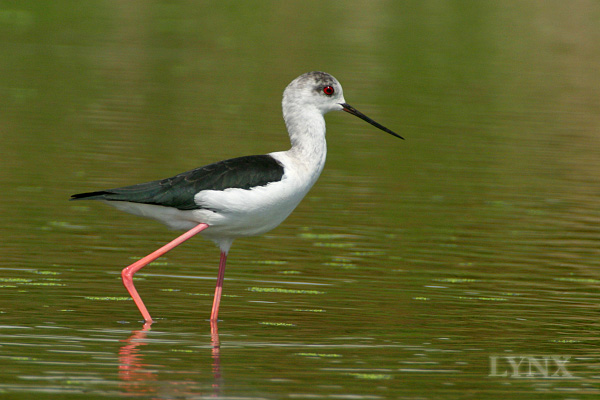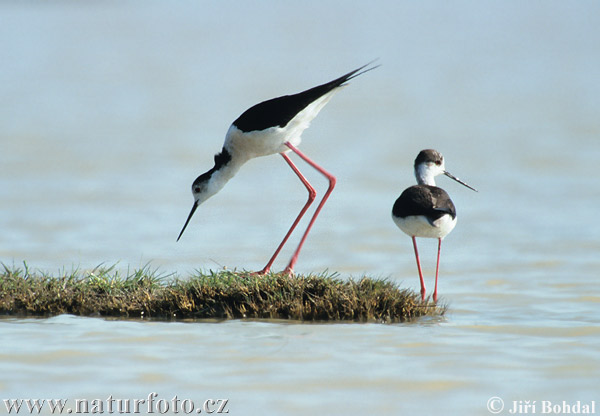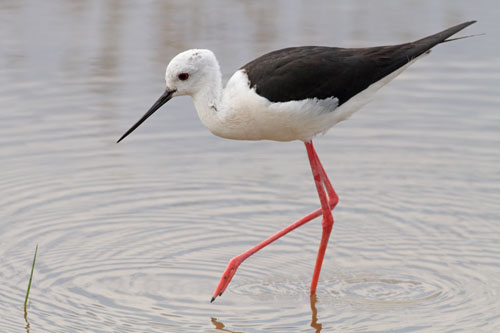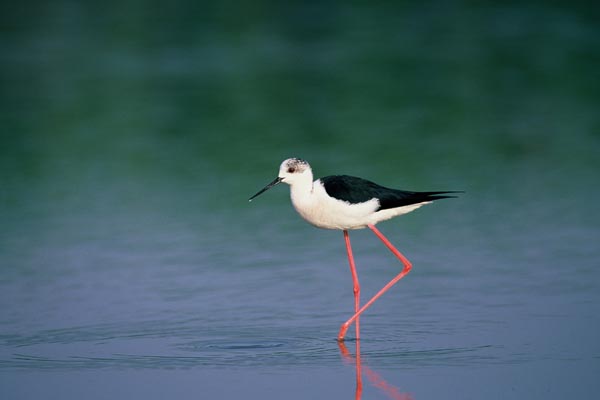
Himantopus himantopus
SUBFAMILY
Recurvirostrinae
TAXONOMY
Charadrius himantopus Linnaeus, 1758, southern Europe. Forms
superspecies with black stilt (Himantopus novaezelandiae), sometimes
considered conspecific. Races can be split into three
groups (“nominate” race, “pied” race, and “black-necked” race)
and 2–5 separate species recognized.
OTHER COMMON NAMES
English: Common stilt; French: Йchasse blanche; German:
Stelzenlдufer; Spanish: Cigьeсuela Comъn.
PHYSICAL CHARACTERISTICS
13.7–15.7 in (35–40 cm), 5.8–7.2 oz (166–205 g). All have extraordinarily
long, pink legs and long black, straight or slightly
upcurved bills. Male’s back and wings black, sometimes with
greenish sheen, white below, gray banding on white tail. Upper
parts of female dullish brown. Juvenile resembles adult female.
Races differ in head and hindneck plumage color, from mainly
white to continuous black. Sexual dimorphism is more evident
in some races.
DISTRIBUTION
H. h. himantopus Linnaeus, 1758, France and Iberia south to
sub-Saharan Africa and Madagascar, east to central Asia and
northern central China, Indochina, Taiwan, and Indian subcontinent.
H. h. leucocephalus Gould 1837, Java east to New
Guinea, south to Australia and New Zealand; winters north to
Philippines, Greater Sundas, and Sulawesi. H. h. knudseni Stejneger,
1887, Hawaiian Islands. H. h. mexicanus P.L.S. Mдller,
western and southern United States to Central America, West
Indies, to southwestern Peru, eastern Ecuador, and northeastern
Brazil. H. h. melanurus Vieillot, 1817, northern Chile and
eastern central Peru through Bolivia and Paraguay to southeastern
Brazil, and south to south central Argentina.
HABITAT
Temperate and tropical shallow wetlands. Usually breeds in
freshwater, including lake edges, marshes, swamps, river-beds
and flooded fields, also found in coastal salt marshes.
BEHAVIOR
Gregarious, may feed in flocks of several thousand birds.
Alarmed birds often head-bob. Call is a sharp monosyllabic
“yep” or “kek.” Sometimes performs a high-leaping display
with a “floating” descent, the significance of this performance
isn’t clear. “Mob-display” also observed, whereby a few birds
come together and behave in a mildly aggressive fashion for no
apparent reason.
FEEDING ECOLOGY AND DIET
Diet strongly seasonal depending on habitat. Preys on various
aquatic invertebrates including insects, small mollusks, crustaceans,
and worms, as well as small fish and their eggs, and
tadpoles. Active forager, employs a variety of methods to capture
prey. Well-adapted to nocturnal vision, these birds will
feed on windy, moonless nights.
REPRODUCTIVE BIOLOGY
Usually breeds in colonies of two to 50 pairs. Timing of breeding
quite variable over range. Nests often widely spaced on
ground or among grasses, sometimes a well-lined, floating
mass of water weeds. Incubation of four eggs 22–26 days, by
both sexes. Fledging 28–37 days.
CONSERVATION STATUS
Not globally threatened but controversial taxonomy calls for
monitoring at subspecific level. Hawaiian subspecies knudseni is
endangered, survival depends on predator control and protection
of nesting habitat. As of 2001 only 1,800 birds. Nominate
race was in decline in the 1800s, but has rebounded with population
estimates now at minimum of 21,000 pairs.
SIGNIFICANCE TO HUMANS
None known.
Other popular Animals
Photo Gallery of - Black-winged stilt




 Animalia Life
Animalia Life